Please note: TGTB has updated most of these subjects since this review was last updated in May 2020. I plan to do a complete revamp of this post soon. Please comment below which subjects I should review first!
*This May 2020 post is a significant update from our original review post in November 2017 and includes several new subjects and levels.
My family has been homeschooling since my oldest (almost 11) started preschool. After many, many, many hours researching curriculum and homeschooling methods, trying countless programs, and a lot of prayer, The Good and The Beautiful (TGTB) has been our core curriculum for the past four years.
Currently, our five and seven-year-old girls and our nine and ten-year-old boys are using this curriculum, often joined by our 18-month-old daughter sidekick.
This detailed review covers all of the subjects our family has used from this curriculum company and our honest experiences with each level, including the pros and cons for our family.
For sample pages and video flip throughs, lists of what each course set includes, other reviews, or to purchase the curriculum, you can go to the TGTB website. Each heading in this review will take you to that subject’s description page.
Please check out my overall review of The Good & The Beautiful if you’d like to read that first. Let’s jump into the subjects!
*This post may contain affiliate links. However, we are not affiliated in any way with The Good & The Beautiful company and all opinions are our own.

Individual TGTB Subjects
(Designed to be used one-on-one with the instructor)
The Good & The Beautiful Language Arts

TGTB LA Level Pre-K
The Pre-K level covers topics like letters and number recognition, letter sounds, fine motor skills, simple rhyming, and shapes.
Pre-K Pros
My daughters both used the preschool book when they were three and absolutely loved it! Our family keeps preschool academic work light, with lots of reading and play. This level was perfect for doing “school” like their big brothers and provided a good foundation for later levels.
I reused the letter Flip Books and Activity Packet for my younger daughter, but they each used their own Course Book.
They both begged to do the “Puppy Book” (because of the cover) every day which is high praise! Their favorite parts were the Flip Books and activities like watercolor letters.
I loved that this level needed almost no prep and used basic supplies for the activities that I already had at home. It was also important to me that my children thought school was fun and engaging.
I don’t have any cons to share about this level! I’m excited to use it with my youngest in a few years.
TGTB LA Level K Primer
The K Primer expands on skills from the Pre-K book including long and short vowel sounds, reading simple two- and three-letter words, sight words, and counting from 10-15.
K Primer Pros
The K Primer was another hit for my girls! They used it when they were age four/early five. We all loved the colorful illustrations and the My First Reading Book. This level also required almost no prep for me which was so helpful as a busy mom!
Both of my daughters mastered the skills in this level smoothly and looked forward to using the Primer every school day. I appreciated that the lessons were short and sweet but still effective.
K Primer Cons/Adaptations
Some families in TGTB Facebook groups have shared that their children had a difficult time transitioning to the Level K book after the Primer.
This was our experience with our oldest daughter. She wasn’t ready for the faster pace of blends and digraphs in Level K. We read TGTB Beginner Books and other simple readers for almost a year before restarting Level K at age 6.
However, our second daughter transitioned with no difficulty from K Primer to Level K at age 5 without any supplementation.
TGTB now has a Primer Supplement available that might be a great option for children who aren’t quite ready to start Level K after the Primer.
*We also did not use the 20 Learning Songs for K Primer, but we enjoy other music from TGTB so we would have probably enjoyed it.
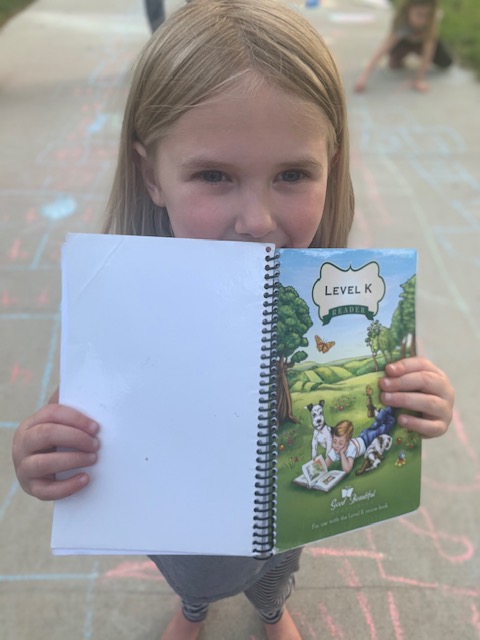
TGTB LA Level K
I highly recommend using the Placement Tests on the website for LA Levels K-7! TGTB LA does not necessarily correspond to public school grade levels and is considered in general to be more advanced than many other programs.
Level K covers phonics and reading, grammar, spelling, and art.
Level K Pros
We really love the new edition with more consistent daily lessons. And have I mentioned how much I love open and go, no prep lessons! They’re a lifesaver for teaching 4 different LA levels in our homeschool.
My daughters have enjoyed the variety of activities in the lessons, the Mini Books, and the Reader. The Sight Word Ladders have been effective for them, and they love coloring the animals when they complete a set!
Level K Cons/Adaptations
My older daughter uses the phonics cards and has enjoyed practicing with them, but my younger daughter doesn’t use them at all.
We’ve had to spread out a few of the more intensive reading lessons into a few days for my daughter who has had a more challenging time with reading.
Finally, the course materials can be difficult to keep track of. I’m grateful that my daughters love the mini books, but the books have shown up in all sorts of random places with two children sharing. I wish the books were either in a box or incorporated in the lessons. I keep the books in a Ziploc bag with moderate success.
TGTB LA Level 1
Level 1 includes phonics, reading, spelling, grammar, writing, literature, and art appreciation.
Level 1 Pros
You can download the PDF of this entire level for FREE! We purchased the printed version, but I haven’t seen a curriculum of this quality for free anywhere.
My active tactile learner used this level at age 6/7. I thought it might be too rigorous for him, but he loved it! One of my top homeschool regrets is not starting TGTB with him sooner.
He liked checking off each part of the lesson as he completed it and loved coloring the animals when he mastered sight words. This level was a great confidence booster for my son, and he became a much stronger reader.
The grammar instruction was more thorough than other curricula my family has used.
Level 1 Cons/Adaptations
I did not care for the spelling instruction in this level. I had personally only heard about three of these rules my entire life. As we discussed each rule, my sons quickly pointed out exceptions to each one. And we didn’t do most of the dictation exercises. (Honestly, we did about four.)
The spelling was MUCH better in Level 4 which I’ll address later.
We also didn’t use the Reader or Phonics Cards. My son did not enjoy them and had strong reading skills already, so we focused on other uplifting literature.
*The new edition of Level 1 resolved a con mentioned in the 2017 version of this post. The daily streamlined lessons seem like a great fit for this level versus the varied lesson lengths of the previous edition. I’ll update this review when we use the new version next year!
TGTB LA Levels 2 & 3
I’m combining Levels 2 and 3 because they were very similar as far as pros and cons for our family. Levels 2 and 3 cover phonics and reading, writing, spelling, grammar, vocabulary, geography, and art appreciation.
As a high compliment to the program, after my sons completed their first school year with TGTB LA, they both placed two levels higher on the placement tests. So our oldest skipped LA Level 3 and our second son skipped LA Level 2.
LA Levels 2 & 3 Pros
Both of these levels are also available for free PDF download on their website!
My boys loved the artwork and interesting stories included in the course books. I was also surprised that they both ended up liking and excelling at the sentence diagram and grammar instruction. Most adults I know hated this part of English class and never wanted to hear about past participles again.
I loved watching my sons become stronger writers. And they devour good books! They looked forward to assessments and the target reading races that showed how much they improved over time. This is exactly what I want from a good language arts curriculum.
LA Level 2 & 3 Cons/Adaptations
We haven’t used the updated versions of these levels. I’m excited to use the new editions with our girls! From the samples on the website, I think the consistent length lessons and fewer components to each level will address the issues we had with some lessons being too long.
Yes, I still skipped most of the spelling instruction in these Levels.
**I just ordered the new Level 3 course book for my son to finish the final third of the course. It’s gorgeous, and I think he’ll love it!
TGTB LA Level 4
Level 4 teaches reading, writing, spelling, grammar, vocabulary, literature, geography, and art. This level includes mostly independent work for the student, with smaller sections requiring parental support.
Level 4 Pros
Another free PDF level!
This was my oldest son’s favorite LA level! He loved the variety of exercises for spelling practice and the beautiful books included with the course. The challenging word section, in particular, helped him feel accomplished.
The sentence diagramming instruction in this and previous levels has helped our son become a diagramming rockstar.
The pastel instruction and country posters were also a highlight of this level. I learned a lot too!
Although I missed our longer one-on-one instruction time, this level was a great opportunity to see the fruits of our homeschool efforts so far. Our son flourished with this level and became a much more adept and confident writer, speller, and thinker.
After each lesson, I would think “Wow, he did all of this without any help!”
Level 4 Cons/Adaptations
The only con we found in this level was that LA could run a little long when the assignments included a big pastel or poster project. To solve this issue, we just consolidated some of the pastel lessons into separate time blocks.
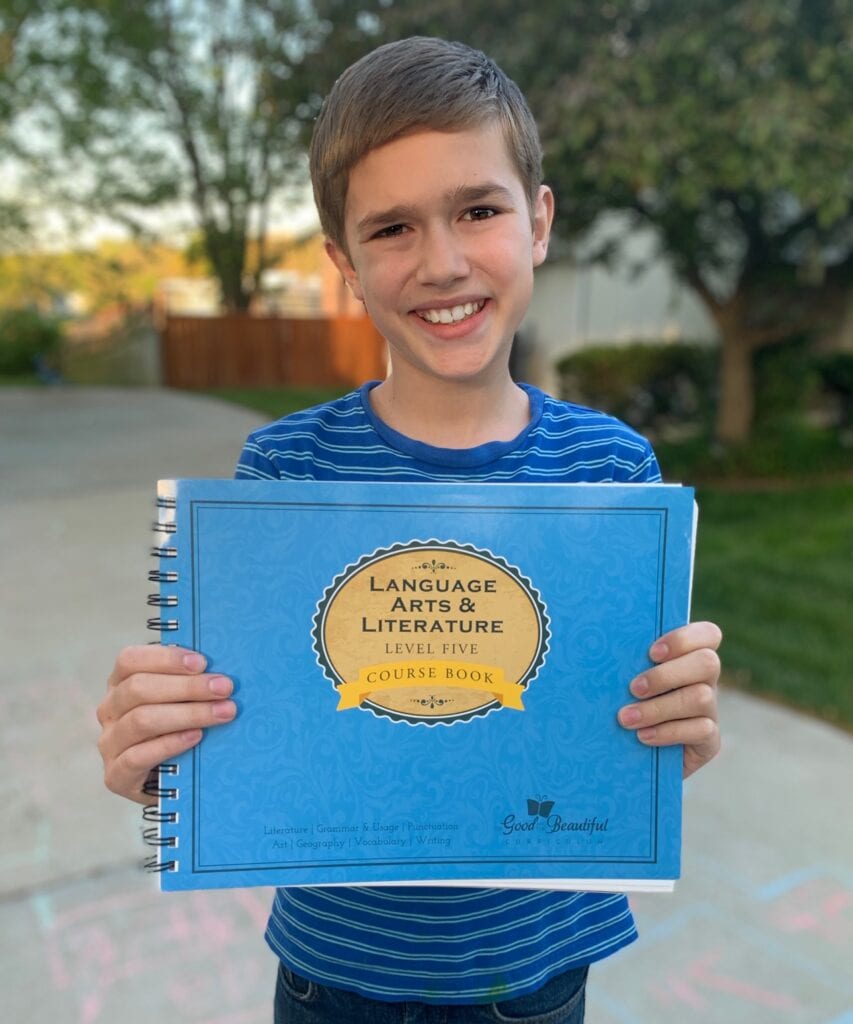
TGTB LA Level 5
Our ten-year-old started this level a few weeks ago, so I cannot make a fair pros/cons list yet. He says he loves the daily checklist and the interesting stories in the readers.
My favorite part of Level 5 so far is the sentence dictation. I know, that doesn’t sound like the most fun. But as I said earlier in the review, I don’t care for TGTB spelling in levels 1-3, so I was concerned the spelling and dictation we skipped in those levels would come back to haunt us.
It hasn’t! Level 4 spelling and lots of time spent reading good and beautiful literature seems to have worked because my son is doing beautifully with spelling in the dication sentences.
*We haven’t used Levels 6 & 7 but plan to use and review them in the future.
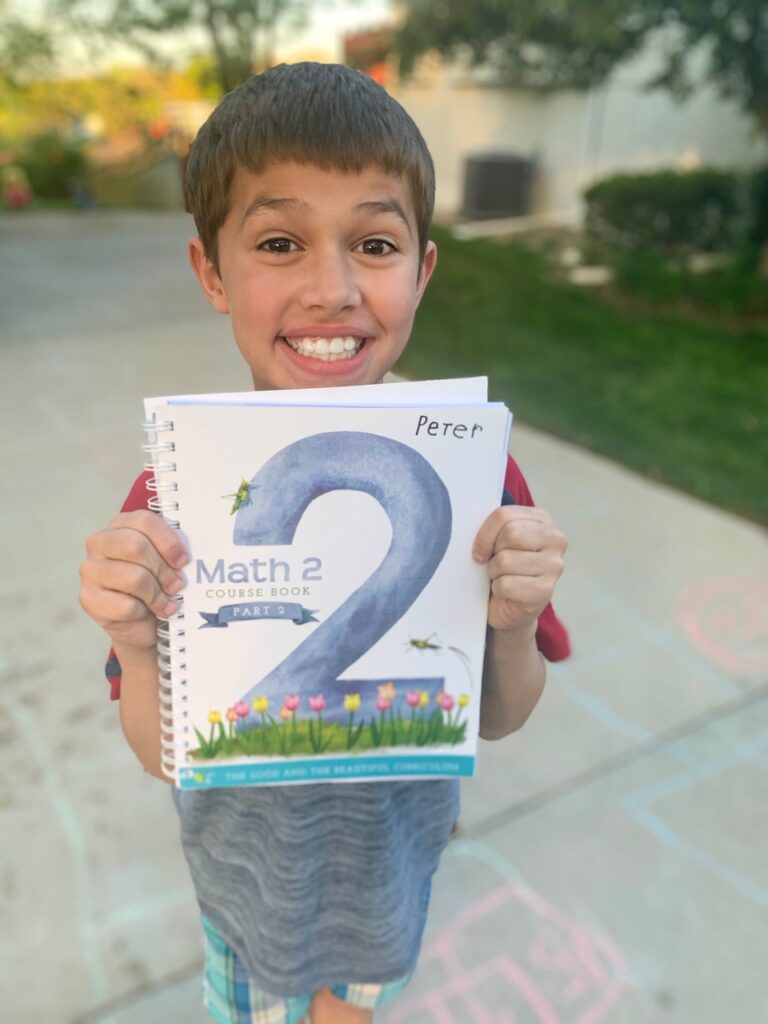
The Good & The Beautiful Math K, 1, & 2
Please see the descriptions of each level for the scope and sequence since they vary for each one. TGTB Math incorporates God, real-life math applications, and beautiful illustrations and stories.
TGTB Math is similar to public school grades, unlike the advanced Language Arts levels.
Math K-2 Pros
TGTB Math has done a great job incorporating different learning styles. There are games and movement for kinesthetic learners, charts and manipulatives for visual learners, songs and stories for audio learners, and many other methods of instruction.
Some families don’t like this variety of teaching styles, but it’s very helpful for my family.
I have one child who has almost completed Math 2, one who has completed K, 1, and half of Math 2, and one child who is halfway through Math K. All three children have very different learning styles and personalities, but they have all loved TGTB Math and have flourished with this program.
TGTB Math has regular review and assessments so it’s simple to see areas where a child might need more practice or instruction. It is also easy to see areas where the child excels.
This Math program has helped my children have solid number sense and have confidence that they can figure out challenging math concepts.
My children all love playing with the Math Activity Boxes–the cubes are a huge hit!
Math K-2 Cons/Adaptations
My oldest wishes TGTB Math had a high enough level for him because he sees how much fun his siblings have with Math. I wish higher levels were available too!
Doing every daily dose, bonus activity, and game can make lessons pretty long, especially if you’re doing multiple math levels each day. I only do every part of the lesson when my child needs extra practice for that math concept. You really don’t have to do every thing!
The boxes for the Math Activity boxes have not held up well at our house, and the storage/upkeep for the games and manipulatives can be tedious.
We often do two math lessons a day, but we only do one daily dose.
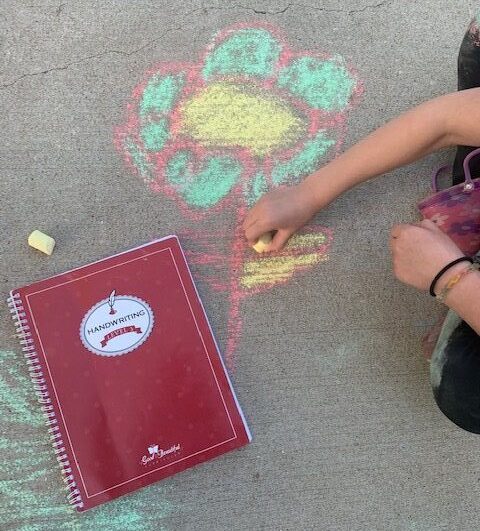
The Good & The Beautiful Handwriting
Handwriting Pros
My family has used Levels K-5 for Handwriting. It’s definitely a favorite subject at our house! The children think it’s great that they can do it mostly on their own and can do it on the trampoline, in the car, or in a pillow fort.
The illustrations are beautiful, and my children LOVE the frequent drawing parts. They usually do one page 4-5 days each week. I have seen improvement in each of my children’s handwriting since they started using these books.
The new rainbow cursive is amazing! The child follows the steps for each letter in rainbow order. My seven-year-old loves that she is able to teach herself “pretty writing.” Even my most reluctant writer looks forward to writing in his book.
Our ten-year-old gets compliments from his grandparents who have beautiful penmanship.
Handwriting Cons
The font and arrows for the lower case “e” in the lower handwriting levels led all of my children to writer their “e’s” backwards when they didn’t do that before this curriculum. It took a few weeks to help them adjust.
I thought we were just weird, but other families have shared the same issue online.
The drawing and coloring elements are perfect for my art-loving family, but this curriculum might not be a great fit for children who do not enjoy drawing and coloring.
TGTB Electives
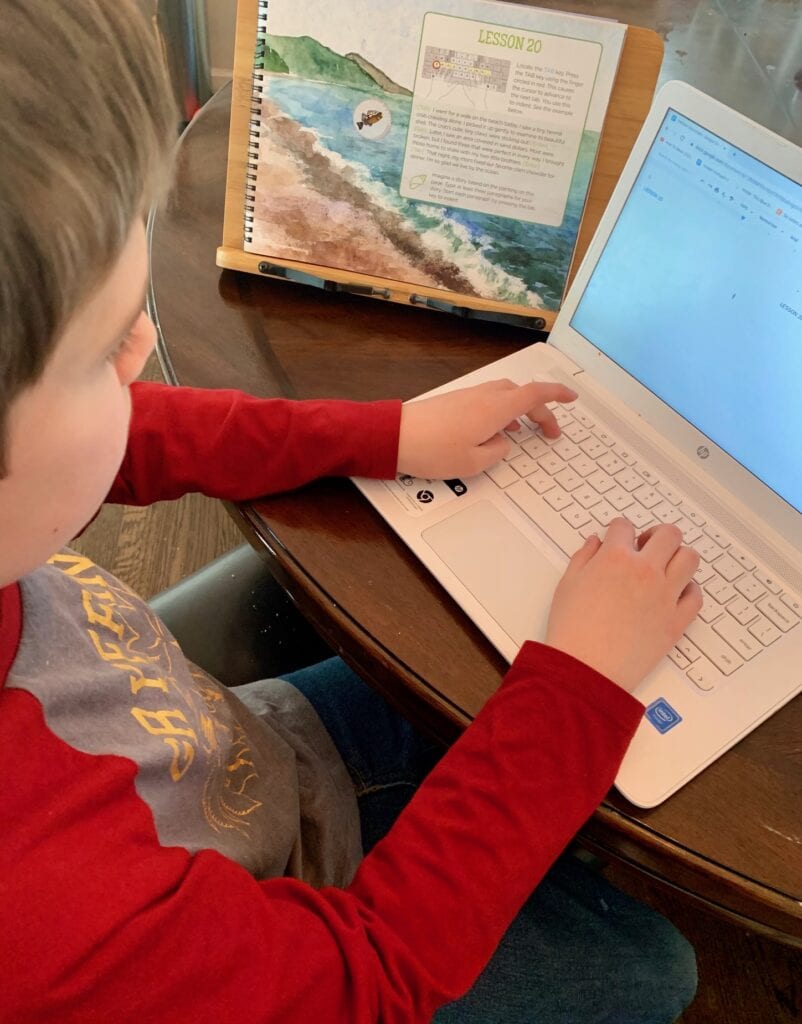
The Good & The Beautiful Typing 1-3
I’m from the Mario Typing generation, so I tried several arcade-style games with my children to teach them typing skills. TGTB Typing program is quite different. I love the video on the description page that explains how the program works.
Typing Pros
Our oldest started TGTB Typing 1 when he was eight, and his typing dramatically improved after just two weeks of lessons.
The lessons are short and focused which has been a perfect fit for our family. Joseph Michael loved that he could get out his recipe stand and Chromebook at any point in the day and complete his typing assignment independently. I only helped with timing assessments.
The Typing programs feature beautiful artwork and quotes and weave spelling, grammar, and poetry into the lessons. It was exciting to hear my son bring up principles he’d learned during his typing lesson.
Joseph Michael finished Typing 3 a few weeks ago and is now a proficient typist and is able to complete many writing assignments on the computer.
Typing Cons
There were a few lessons, especially in Typing 2, when my son was frustrated and felt he was making slow progress. I think this could happen with any typing program, but it wasn’t smooth sailing every day.
I personally don’t think this program would be as effective for younger children who aren’t strong readers yet, versus an online program that will have audio instructions.
TGTB Typing seems best suited for children who are independent learners. My second son isn’t currently motivated to learn typing, so we are waiting a little longer to start this program.
Family-Style TGTB Subjects
(Designed to be used as a group unit-study)
The Good & The Beautiful History 1 & 2

TGTB History is one of my favorite subjects to teach, and all of my children love history now!
TGTB History emphasizes God and moral character and has four levels that each focus on different time periods from ancient-modern history.
History 1 & 2 Pros
This is the only official history curriculum (aka not Liberty’s Kids or Animated Hero Classics videos) that we’ve ever stuck with since we all enjoy it!
The History courses require little to no prep which means I actually do history regularly with my children. We usually do 2-3 lessons a week. The activities are fun and meaningful but don’t take me hours of Pinterest planning to execute.
The Keys of History game has been a great review, and my children look forward to playing it. (We’ve only played the Settlers game a few times, but my children enjoyed it.)
The audio dramatizations feel like old-style radio shows, and as cliche as it sounds, they do help history “come to life” for my family.
Besides being engaging and enlightening for my children, I appreciate that this curriculum doesn’t present “revisionist” history. It even specifically addresses the pitfalls of rewriting history to overemphasize character flaws of historical figures, without glossing over the fact that people sometimes do make poor choices.
History 1 & 2 Cons/Adaptations
I didn’t think the PDF Student Explorers would be our style. When I first downloaded them, they felt like “busy work” with a lot of coloring and maps. However, my children love them and request them while we’re listening to the audio recordings. I don’t require them to complete these.
Some of the lessons have seemed long for my younger children (ages 4 and 6). I always separate the Keys of History game from the rest of the lesson so we aren’t doing too much at once for my children’s attention spans.
Between the Big Book of History stories, the lessons themselves, and the audio dramatizations, TGTB can feel audio-heavy for children who don’t learn as well this way. I have one child who soaks up all the audio content but another who doesn’t.
I try to do history during snack time which helps my younger children/non-auditory learner feel bribed to stay engaged during the lessons.
I have seen several criticisms online of TGTB History being too “white-washed or American/Western-centric.” In my experience, it has been more diverse than the history I learned in public school, but it is good to check out the topics for your own family.
TGTB Science & Health
The Good & The Beautiful Health Science: Safety
I would recommend this course to all parents, even if you don’t homeschool! These are important subjects for all children and in my experience aren’t skills that children just intuitively pick up as they get older.
We’ve completed this unit twice because we loved it so much! It’s still my second son’s favorite school unit ever because the safety rules were explained so well, and he likes discussing real, pertinent topics.
We plan to review this unit annually.
The Safety Course covers:
- Fire Safety
- Water and Electricity
- Earthquakes and Natural Disasters
- God Gave Me a Body
- Home Alone
- Kitchen and Cooking Safety
- Internet and Peer Pressure
- Gun Safety
The lesson lengths were perfect for my children’s attention spans and understanding (ages 4-10). I feel a lot more peace as my children have learned these skills. The activities are fun, helpful, and low prep.

The Good & The Beautiful Science: Botany
I was a floral designer in college, and this unit was perfect for sharing my plant-loving passion with my children. We loved exploring our yard, flower garden, and nature trails along with these lessons.
My children were ages 5-10 when we used the Botany unit, and some of the concepts/vocabulary were advanced for my younger children. We plan to cycle through these units, so they’ll be able to do these lessons again when they’re older.
We particularly enjoyed the Flower lessons and Poisonous/Carnivorous Plants lessons.
The Good & The Beautiful Life Science: The Human Body Part 1
This was our first TGTB Science unit because all of my children expressed interest in this topic.
The vocabulary was a little advanced for my 6-yr-old, but she still liked to participate in the lessons.
**This unit did require a few supplies that I needed to find or purchase ahead of time as they weren’t typical household items.
If your oldest child is in early elementary, I would recommend starting with a different science unit as this one seemed more advanced than others offered by TGTB. Several families have enjoyed starting with Arthropods or the newly released Mammals unit.
The Good & The Beautiful Book List
This list is fantastic. I can’t say enough good things about it. It has over 650 recommended books!! that have high morals, clean language, and interesting storylines.
My children are voracious readers, and it is difficult to screen every book they’d like to read. I love having this go-to list of books that I can trust to be a positive influence on my children.
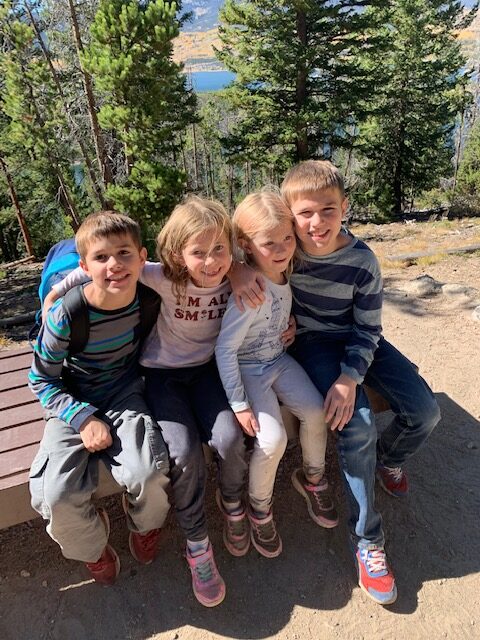
I hope this review has been helpful in considering if this curriculum would be a good fit for your family! I’m happy to answer any questions you have about our experiences with The Good & The Beautiful or homeschooling in general!
You can comment below with questions or email us from our Contact Page.
-Maegan
*We are not affiliated with The Good & The Beautiful and purchased all items used for review. All opinions are my own.
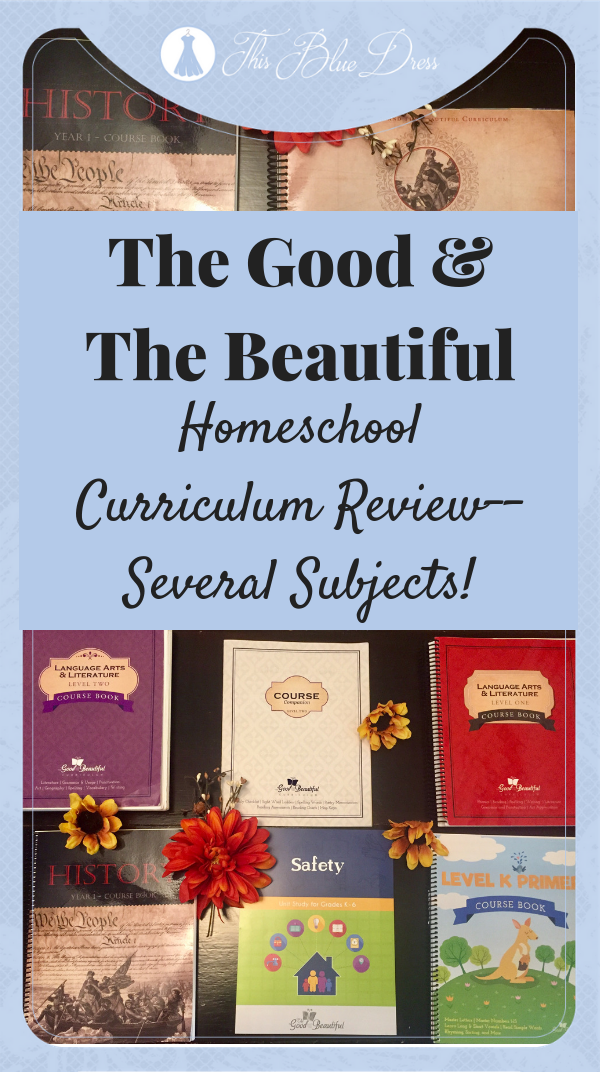

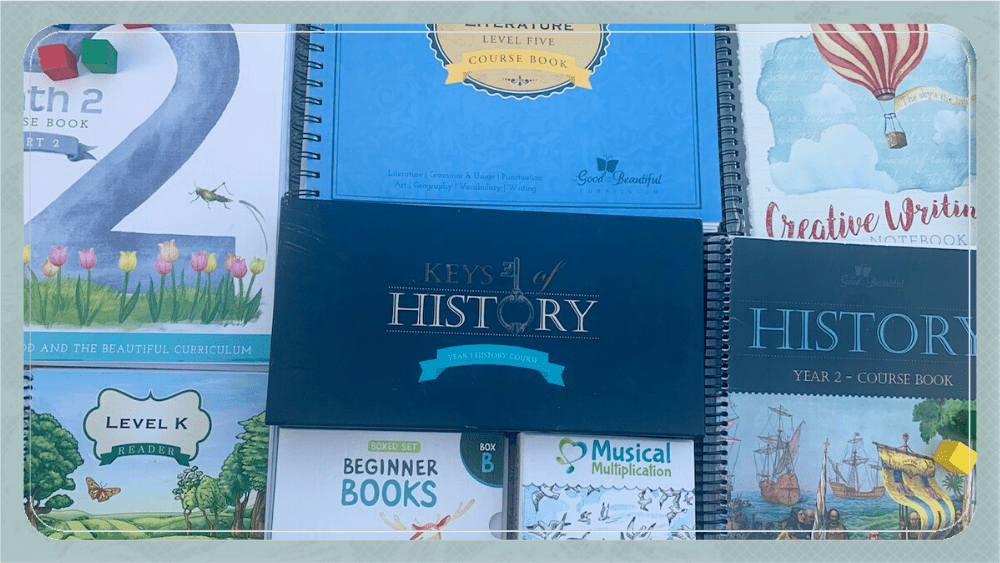
Hi! How much time do you spend in TGTB curriculum each day? And what do you do for math?
I am so sorry I missed responding to your comment!! We spend 1-3 hours a day doing TGTB, depending on if we are doing Science, History, or Art that day. Sometimes 4 hours if I’m doing a “catch-up day”. The most time-consuming part is doing 3 levels of Language Arts with individual children, but I just work with each one until they seem to be at a stopping point for the day versus the recommended time listed in the books.
For Math: Right now my 6-yr-old is doing TGTB Math K, and my 7 & 9-yr-olds are using Prodigy online and the Splash Math app.
How are you enjoying the Math K? Since you have older kids and are doing other math curriculums (since the K is new), I’d like to know your opinion on what you have done vs. what are you now doing with your 6 y/o. Would you buy the next level of TGATB math when it comes out or most likely switch to what you do with your older children?
Hi Lauren! We’re loving Math K. I personally prefer it to other Math programs we’ve used for Kindergarten like Singapore Math (although I like that program also). The “daily dose” section in Math K gets a little dull to me with the repetition, but my daughter loves it. I feel like it’s given my daughter a better foundation for later math principles versus other workbooks my boys used. I’ll definitely be buying TGATB Math 1 for her when it comes out. She might still do some Prodigy math practice like her brothers as she gets older, but as long as TGATB Math stays the same format/quality in later levels I’ll likely still with that as her core math.
Hope that helps and please let me know if you have any other questions!
Can’t thank you enough for this review – a timely blessing from God! New homeschool Mama of 7yo/5yo/3yo boys. I purchased curriculum and realized it was not what I wanted (go figure). After even more research, I found TGATB. I have loved everything I can see from their websit, but I wanted to hear what others have thought through their experiences. This post has been very beneficial. Thank you for taking the time to share in such detail.
Thank you for your sweet comment, Laura! Good luck with your homeschool! I hope you all have a lot of fun learning together. Please let me know if I can help with any questions about homeschooling/TGATB in the future!
Thank you for your reviews! I’m coming from a Charlotte Mason background where lessons are short and not textbook/Fact-heavy. Have you noticed science being overwhelming for 7-9 yr olds; specifically fidgety, short attention span- children?
Thanks for the helpful review!
I have never bought a full curriculum before and I get worried about using it properly. I was also wondering if the History touches on the constitution at all.
Hi Venice, I’m so glad it was helpful! I think it’s important to remember that you can make any curriculum that you choose work for you and your family! The two years of History that my family has used both covered the Constitution. I think History 3 goes even more into depth with the Bill of Rights. The samples on TGTB site are great for seeing what each unit covers throughout the four books. Please let me know if you have any other questions! -Maegan
I love the math from the Good and the Beautiful. I so wish I could get it for my rising 5th grader. What curriculum do you use for math for your older kids?
Hi Amanda, I wish TGTB Math was ready for my older children too! In the past, we’ve used Prodigy and Math Mammoth. We’re currently using Beast Academy and enjoying it. Thanks for commenting! -Maegan
Hi Amanda – if you’ve had a chance to watch the YouTuber Ashlee of GraceAndGrit she transitions her children from TGTB to Saxon math and it seems to work well and people going from Saxon seem to transition from that to Shormann at the high school level. So that might be a curriculum you’d be interested in looking into.
Hi! I appreciate your in depth review of this curriculum. I like many other parents am considering homeschooling this year, unfortunately for me I am making a late decision. TGTB seems like a really great curriculum, and we would be willing to invest in it. However, everything I need my K and 2nd grade is out of stock and pdf only. I’m curious is you used the PDFs and just got it printed. This seems silly but curious best route to print the material as seems pricey to get it all printed. Thanks!
Hi Kate, I’m so glad the review was helpful! I personally don’t have experience printing the PDFs, but I can hopefully point you in a good direction! There is a Facebook group called The Good & the Beautiful Community that has lots of good info. If you join that and search for “printing company recommendations” there is a great thread with several companies suggested. I often see Family Nest Printing and The Homeschool Printing Company recommended, but I’ve never used them so I can’t share any experience. Big Box stores are usually much more expensive for printing. Some families do the DIY route with Eco Tank printers or the HP Instant Ink Printer I mentioned in my post. If you go to TGTB main website, they recently set up text alerts for restock info and often include that in their emails as well. I know they just had a big restock for Math and LA. Please let me know if you have any other questions about TGTB or homeschooling, and good luck with your family’s journey! -Maegan
Hi Maegan, Thanks so much for this detailed review! I read this as we were considering our fall choices and your review gave me confidence in my decision. (We’re new homeschoolers this year and loving every minute.) My question for you is what you do for science for your older kids? I have an 8th grader and we’ve started the botany unit and love it for my younger two, but even the extensions just don’t seem like enough for him. Any suggestions or wisdom from the trenches?? 🙂
Hi Colette, I’m so glad the review was helpful and that homeschooling is going well for your family! Exciting! That’s great that your son is advanced enough to need additional science. My oldest son (11) is still wrapping up a few more science units from TGTB before we decide on his next route for science. Here are some of my thoughts on late Middle School/High School science and what I’ve seen in recommended in the homeschool community, but please know that this doesn’t come from actual experience yet since we aren’t that far in our journey.
Once our children complete 8th grade/middle school, we plan to help them do classes through dual enrollment programs so they can graduate high school with at least an Associate’s degree. We’ll likely go that route for science. My daughter (8) has always shown interest in nursing, so she’ll likely have a heavier emphasis on anatomy, biology, etc. As far as science curriculum suggestions, unfortunately, there isn’t one I’ve heard of that a huge group of homeschoolers absolutely love. I have seen Berean Builders, Super Charged Science, BJU Distance Learning, and MEL Science mentioned frequently in TGTB Facebook groups. I hope some of this is helpful. 🙂 I’d love to hear what you end up choosing to do for science! -Maegan
Hi Maegan, I would be interested in hearing more about your plans for the dual enrollment in High School and Associate’s degree. Any help is appreciated.
thanks!
Hi there, thank you for taking the time to review this curriculum!! I am considering this for my 2nd grade sone but am curious if you purchased on the exclusive reading books from TGTB or if that was even required. I love the pricing of the curriculum but the total cost of the books on the book list are well over $200. Any advice on whether that is a necessary purchase? Thanks again!!
Hi Erica, I’m sorry I missed your comment before! You definitely do not have to purchase reading books from TGTB! They do have readers that come as part of the language arts curriculum, but honestly I haven’t used those for most of my children. The books from the book list and their library are just great books that have met a specific literary standard. You can learn more about these standards here: https://www.youtube.com/watch?v=0qI1-pGiqJ0 (from TGTB youtube channel). I have loved the books we’ve purchased from their book list, but they are not essential for doing the curriculum and are more for building an uplifting home library at your own pace. Good luck with your homeschool year!
Thanks so much for your detailed and honest reviews.
I’m curious if you feel as though the stories and images through TGTB are ethnically diverse or more Eurocentric?
Hi Piper, thank you for your comment! I’ve read that TGTB is prioritizing adding more diversity to their materials, and this has definitely been reflected in their most recent releases. The new version of the readers has much more diverse images. Some people feel TGTB History is more Eurocentric. I’m curious to see if that will be addressed in the newer version, but that is projected to be released in a few years. I personally like the history and add literature picks from sources like Give Your Child the World: Raising Globally Minded Kids One Book at a Time and similar lists. Please let me know if you have any other questions!
Hi there I am new to the homeschooling group and I have a four-year-old and a seven-year-old both with ADHD. How does the program work when you have multiple children? Can you work with one child while the other is working independently? Is this a more hands on program for parents? Also I was looking at it online and it just seems like a lot of detailed information and a lot of material instead of being on the computer for 3 hours with minimal intervention. My mother goes to church with a woman who suggested this program.
Hi Rachel, since your children are young, they might not be able to do as much work independently. My older children do their independent subjects while I work with my younger children, and then we do subjects like science together. TGTB curriculum is more parent-intensive in the early elementary years. However, if your children are independent readers, they could do some of the coursework on their own. TGTB will definitely be more parent intensive than computer-based programs like Easy Peasy or online public school. TGTB is more “open and go” than other book-based curriculum options because you read directly from the coursebook, especially for language arts and math. Science and history do require some minimal printing/prep and gathering some simple supplies for experiments. Please let me know if you have any other questions!
Hi Julia, I’m sorry it won’t let me respond to your question in the thread. I will try to email you this response also. TGTB leans Charlotte Mason style in many ways, but TGTB Science, in my opinion, is more fact-heavy for elementary than most elementary science curriculum I have used or researched. It’s definitely more info than I learned in my public school elementary science classes. This works great for my family because my focus for science at this age is more exploratory/exposure than mastery-based. We have snack time during the reading part and try to do a lot of the experiments to keep my wiggly younger ones engaged. The marine biology unit is available as a free PDF, so that might be a great place to start to see if TGTB is a good fit for your family. We haven’t done that one, but my children have particularly loved the botany and mammals units. Please let me know if you have any other questions!
Hi there! This is my first year homeschooling a 10 yr old and 4 yr olds. We have been using TGTB and love it however it has been the only thing we have used :). I am struggling understanding the grading/testing process. Normal public school would have had many test. The math and lay gauge TGTB has assessment reviews but what do you do for history and science? How do you test your children and if you don’t test how do you make sure they comprehend what they are being taught. Thank you for your thoughts!